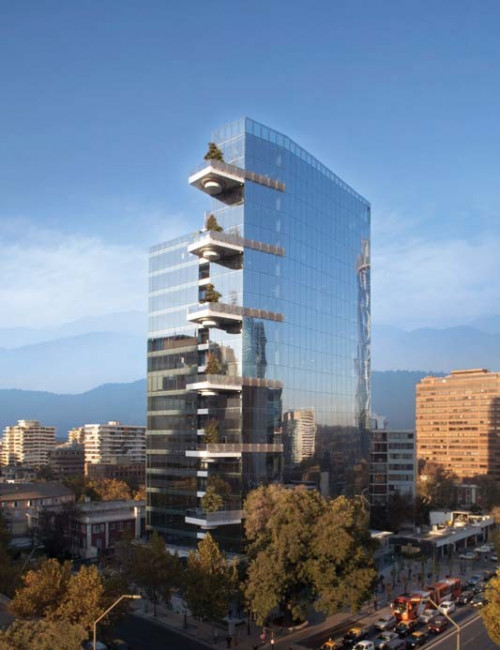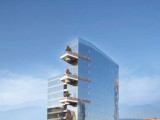Territoria El Bosque
Santiago
- Facts
-
Metrics
You must be a CTBUH Member to view this resource.
Official Name
Territoria El Bosque
Type
Building
Status
Completed
Completion
2013
Country
City
Address
Function
A mixed-use tall building contains two or more functions (or uses), where each of the functions occupy a significant proportion of the tower's total space. Support areas such as car parks and mechanical plant space do not constitute mixed-use functions. Functions are denoted on CTBUH "Tallest Building" lists in descending order, e.g., "hotel/office" indicates hotel function above office function.
Office
Structural Material
Both the main vertical/lateral structural elements and the floor spanning systems are constructed from steel. Note that a building of steel construction with a floor system of concrete planks or concrete slab on top of steel beams is still considered an “all-steel” structure as the concrete elements are not acting as the primary structure.
All-Concrete
Both the main vertical/lateral structural elements and the floor spanning systems are constructed from concrete which has been cast in place and utilizes steel reinforcement bars and/or steel reinforced concrete which has been precast as individual components and assembled together on-site.
All-Timber
Both the main vertical/lateral structural elements and the floor spanning systems are constructed from timber. An all-timber structure may include the use of localized non-timber connections between timber elements. Note that a building of timber construction with a floor system of concrete planks or concrete slab on top of timber beams is still considered an “all-timber” structure as the concrete elements are not acting as the primary structure.
Mixed-Structure
Utilizes distinct systems (e.g. all-steel, all-concrete, all-timber), one on top of the other. For example, a Steel Over Concrete indicates an all-steel structural system located on top of an all-concrete structural system, with the opposite true of Concrete Over Steel.
Composite
A combination of materials (e.g. steel, concrete, timber) are used together in the main structural elements. Examples include buildings which utilize: steel columns with a floor system of reinforced concrete beams; a steel frame system with a concrete core; concrete-encased steel columns; concrete-filled steel tubes; etc. Where known, the CTBUH database breaks out the materials used within a composite building’s primary structural elements.
All-Concrete
Energy Label
LEED Gold
Height
74.2 m / 243 ft
Floors Above Ground
20
Floors Below Ground
4
# of Parking Spaces
370
# of Elevators
8
Tower GFA
32,000 m² / 344,445 ft²
Rankings
-
By function
You must be a CTBUH Member to view this resource.
-
By material
You must be a CTBUH Member to view this resource.
Construction Schedule
Proposed
Construction Start
Completed
You must be a CTBUH Member to view this resource.
Owner
GLL Real Estate Partners GmbH
Territoria
Developer
Territoria
Architect
Usually involved in the front end design, with a "typical" condition being that of a leadership role through either Schematic Design or Design Development, and then a monitoring role through the CD and CA phases.
Handel Architects LLP
Usually takes on the balance of the architectural effort not executed by the "Design Architect," typically responsible for the construction documents, conforming to local codes, etc. May often be referred to as "Executive," "Associate," or "Local" Architect, however, for consistency CTBUH uses the term "Architect of Record" exclusively.
Uno Proyectos
Structural Engineer
The Design Engineer is usually involved in the front end design, typically taking the leadership role in the Schematic Design and Design Development, and then a monitoring role through the CD and CA phases.
Santolaya Ingenieros Consultores
The Peer Review Engineer traditionally comments on the information produced by another party, and to render second opinions, but not to initiate what the design looks like from the start.
Alonso Larrin Evaristo
MEP Engineer
The Design Engineer is usually involved in the front end design, typically taking the leadership role in the Schematic Design and Design Development, and then a monitoring role through the CD and CA phases.
Enrique Montoya Ingenieria Ltda.; Fleischmann Ingenieria de Proyectos Ltda.; Gormaz y Zenteno Ltda.
Contractor
The main contractor is the supervisory contractor of all construction work on a project, management of sub-contractors and vendors, etc. May be referred to as "Construction Manager," however, for consistency CTBUH uses the term "Main Contractor" exclusively.
Sigro
Other Consultant
Other Consultant refers to other organizations which provided significant consultation services for a building project (e.g. wind consultants, environmental consultants, fire and life safety consultants, etc).
Other Consultant refers to other organizations which provided significant consultation services for a building project (e.g. wind consultants, environmental consultants, fire and life safety consultants, etc).
AEV Topografia
These are firms that consult on the design of a building's façade. May often be referred to as "Cladding," "Envelope," "Exterior Wall," or "Curtain Wall" Consultant, however, for consistency CTBUH uses the term "Façade Consultant" exclusively.
Accura Systems
EBV Fire & Security
Ruz & Vukasovic
Energy 3Arq
EBV Fire & Security
ARC Consultores
Heavenward
About Territoria El Bosque
Territoria El Bosque is a LEED Gold office building in Apoquindo, the business and financial district of Santiago, Chile. Situated at an important intersection, the site is adjacent to a 300-year old ceibo, a flowering tree found throughout South America. The tree has become a local landmark, and its prominence and beauty heavily influenced the building’s architectural expression.
A reflective silvery-blue glass covers the northern volume, while the southern volume incorporates a mesh screen into the facade, giving the building texture and distinctly breaking up the mass. The screens, which vary in opacity depending on which facade they sit, are placed slightly away from the building, which allows the light to play on the glass behind them. The building’s most spectacular feature directly references the landmark and Santiago’s history of incorporating landscape into building facades: circular tree-boxes contain camphor trees at balconies on every third floor. Additionally, the rooftop garden features extensive landscaping with local greenery, and was designed to be highly water efficient.
Subscribe below to receive periodic updates from CTBUH on the latest Tall Building and Urban news and CTBUH initiatives, including our monthly newsletter. Fields with a red asterisk (*) next to them are required.
View our privacy policy


